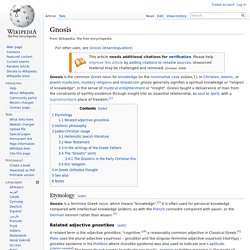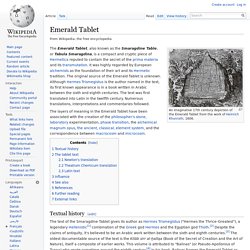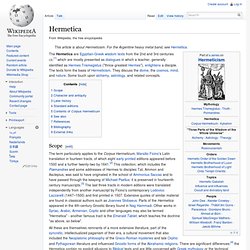

Gnosis. Etymology[edit] Gnosis is a feminine Greek noun, which means "knowledge".[2] It is often used for personal knowledge compared with intellectual knowledge (eidein), as with the French connaitre compared with savoir, or the German kennen rather than wissen.[3] Related adjective gnostikos[edit] A related term is the adjective gnostikos, "cognitive,"[4] a reasonably common adjective in Classical Greek.[5] Plato uses the plural adjective γνωστικοί – gnostikoi and the singular feminine adjective γνωστικὴ ἐπιστήμη – gnostike episteme in his Politikos where Gnostike episteme was also used to indicate one's aptitude.

Quatre sens de l'Écriture. Un article de Wikipédia, l'encyclopédie libre.

Par les quatre sens de l'Écriture, il faut entendre les quatre types ou niveaux de lecture que proposent le judaïsme et le christianisme des écritures sacrées. Ces quatre sens sont Historique[modifier | modifier le code] Catégorie:Gnosticisme. Category:Gnosticism. Portal:Occult. Catégorie:Occultisme. Category:Occult. Paranormal influences, agencies, or phenomena available only to the initiated while hidden from others.

Articles on items commonly used by occultists such as tarot cards and runes may also be in this category. Level of consciousness (Esotericism) Consciousness is a loosely defined concept that addresses the human awareness of both internal and external stimuli.

This can refer to spiritual recognition, psychological understanding, medically altered states, or more modern-day concepts of life purpose, satisfaction, and self-actualization. Most theories map consciousness in a series of levels, some stages of which are more continuous or complex than others. Movement between stages is often bidirectional depending on internal and external conditions, with each mental ascension precipitating a change in reactivity. Emerald Tablet. An imaginative 17th century depiction of the Emerald Tablet from the work of Heinrich Khunrath, 1606.

The Emerald Tablet, also known as the Smaragdine Table, or Tabula Smaragdina, is a compact and cryptic piece of Hermetica reputed to contain the secret of the prima materia and its transmutation. It was highly regarded by European alchemists as the foundation of their art and its Hermetic tradition. The original source of the Emerald Tablet is unknown. Although Hermes Trismegistus is the author named in the text, its first known appearance is in a book written in Arabic between the sixth and eighth centuries.
The text was first translated into Latin in the twelfth century. The_rapture_of_incarnation_by_artofwarstudios.jpg. Esotericism. Esotericism (or esoterism) signifies the holding of esoteric opinions or beliefs,[1] that is, ideas preserved or understood by a small group of those specially initiated, or of rare or unusual interest.[2] The term derives from the Greek, either from the comparative ἐσώτερος (esôteros), "inner", or from its derived adjective ἐσωτερικός (esôterikos), "pertaining to the innermost".[3] The term can also refer to the academic study of esoteric religious movements and philosophies, or to the study of those religious movements and philosophies whose proponents distinguish their beliefs, practices, and experiences from mainstream exoteric and more dogmatic institutionalized traditions.[4]

Ésotérisme. Catégorie:Ésotérisme. Category:Esotericism. Subcategories This category has the following 16 subcategories, out of 16 total.

Pages in category "Esotericism" The following 73 pages are in this category, out of 73 total. This list may not reflect recent changes (learn more). Category:Secret societies. Category:Collegiate secret societies. Skull and Bones. History[edit] Skull and Bones was founded in 1832 after a dispute between Yale debating societies Linonia, Brothers in Unity, and the Calliopean Society over that season's Phi Beta Kappa awards.

It was co-founded by William Huntington Russell and Alphonso Taft as "the Order of the Skull and Bones".[2][3] Catégorie:Société secrète ou fraternité. Hermeticism. Not to be confused with Hermit.

Hermeticism, also called Hermetism,[1][2] is a religious and philosophical/esoteric tradition based primarily upon writings attributed to Hermes Trismegistus ("Thrice Great").[3] These writings have greatly influenced the Western esoteric tradition and were considered to be of great importance during both the Renaissance[4] and the Reformation.[5] The tradition claims descent from a prisca theologia, a doctrine that affirms the existence of a single, true theology that is present in all religions and that was given by God to man in antiquity.[6][7]
Hermétisme. Hermetica. Scope[edit] The term particularly applies to the Corpus Hermeticum, Marsilio Ficino's Latin translation in fourteen tracts, of which eight early printed editions appeared before 1500 and a further twenty-two by 1641.[2] This collection, which includes the Pœmandres and some addresses of Hermes to disciples Tat, Ammon and Asclepius, was said to have originated in the school of Ammonius Saccas and to have passed through the keeping of Michael Psellus: it is preserved in fourteenth century manuscripts.[3] The last three tracts in modern editions were translated independently from another manuscript by Ficino's contemporary Lodovico Lazzarelli (1447–1500) and first printed in 1507.

Extensive quotes of similar material are found in classical authors such as Joannes Stobaeus. Parts of the Hermetica appeared in the 4th-century Gnostic library found in Nag Hammadi. Catégorie:Hermétisme. Théosophie. Un article de Wikipédia, l'encyclopédie libre. Emblème de la société théosophique. Les cinq symboles visibles dans le sceau sont l'Étoile de David, l'Ânkh, la Sauvastika, l'Ouroboros et, au-dessus du sceau, le signe Aum.
Autour du sceau sont écrits les mots : « Il n'y a pas de religion supérieure à la Vérité ». Le terme théosophie fait référence à un système philosophique ésotérique à travers lequel l'être humain tente de connaître « le Divin » et les mystères de la Vérité. La « théosophie antique » est à distinguer de la « théosophie moderne » ou « théosophisme »[1] se référant à la Société théosophique. Théosophie antique[modifier | modifier le code] Fraternité blanche universelle. Un article de Wikipédia, l'encyclopédie libre.
La Fraternité blanche universelle se définit comme une association initiatique, fondée par Peter Deunov en Bulgarie en 1922, dont une nouvelle branche a été initiée en France par un disciple, Omraam Mikhaël Aïvanhov. Le 24 février 1922, Peter Deunov ouvre une école ésotérique à Sofia en Bulgarie portant le nom de Fraternité Blanche Universelle. Esoteric cosmology. Overview[edit] Examples of esoteric cosmologies can be found in Gnosticism, Neoplatonism, Nagualism (Carlos Castaneda), Tantra (especially Kashmir Shaivism), Kabbalah, Sufism, the teachings of Jacob Boehme, The Urantia Book, the Sant Mat/Surat Shabda Yoga tradition, Theosophy, Anthroposophy, The Cosmic Tradition of Max Theon and his wife, Max Heindel (The Rosicrucian Cosmo-Conception), elements of the teachings of Sri Aurobindo, Meher Baba, the Fourth Way propounded by Gurdjieff and Ouspensky, PaGaian Cosmology and many current New Age teachings, to give only a few examples.[2] Gnosticism[edit] Gnostic teachings were contemporary with those of Neoplatonism.
Category:Alchemy. Catégorie:Alchimie. Category:Religious behaviour and experience. Category:Paranormal. Portail:Religions et croyances. Category:Religious belief and doctrine. Category:Esoteric schools of thought. Category:Esoteric Christianity. Esoteric Christianity refers to the study of the occult or mystic esoteric knowledge related to the inner teachings of Christianity.
The term is generally associated with the Essenes and later the Rosicrucians. In esoteric Christianity, the religion of the Christ is taught as a mystery religion. Subcategories.